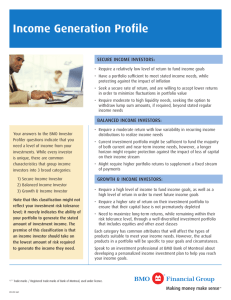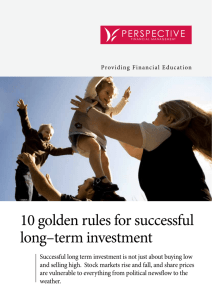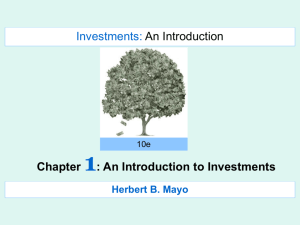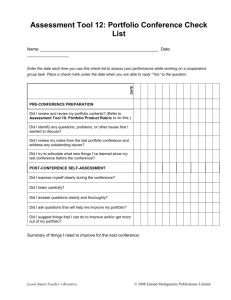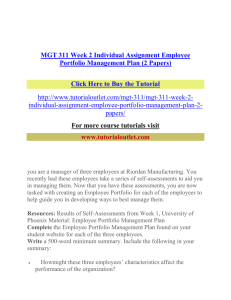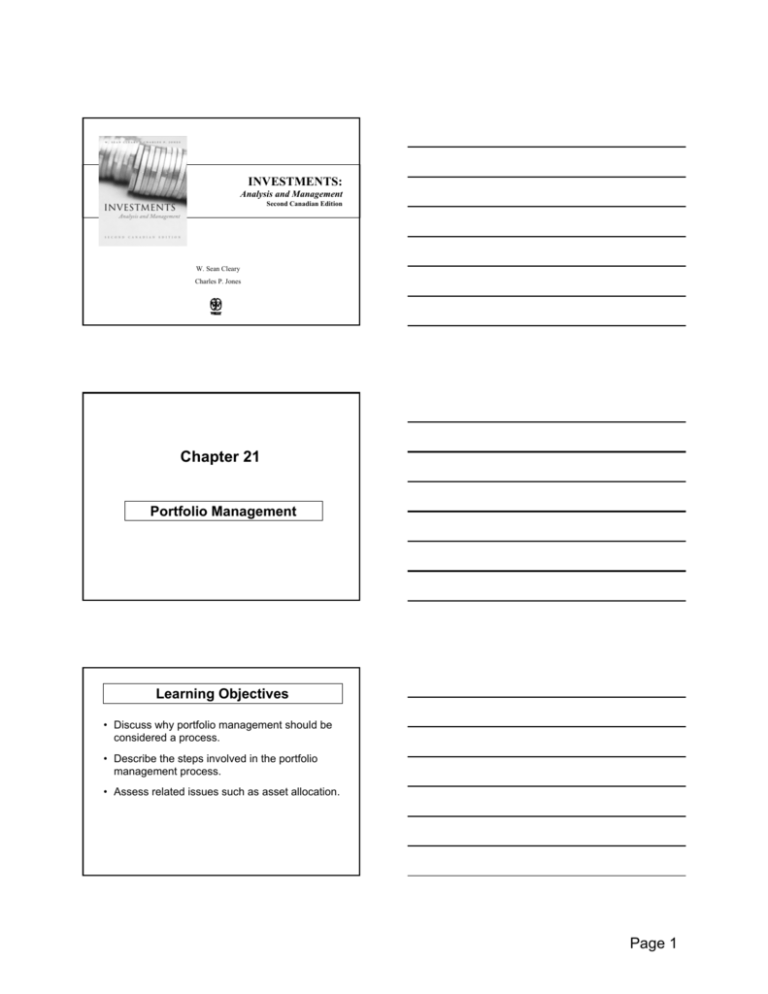
INVESTMENTS:
Analysis and Management
Second Canadian Edition
W. Sean Cleary
Charles P. Jones
Chapter 21
Portfolio Management
Learning Objectives
• Discuss why portfolio management should be
considered a process.
• Describe the steps involved in the portfolio
management process.
• Assess related issues such as asset allocation.
Page 1
Portfolio Management
• Involves decisions that must be made by every
investor whether an active or passive investment
approach is followed
• Relationships between various investment
alternatives must be considered if an investor is
to hold an optimal portfolio
Portfolio Management as a
Process
• Definite structure everyone can follow
• Integrates a set of activities in a logical and
orderly manner
• Continuous and systematic
• Encompasses all portfolio investments
• With a structured process, anyone can execute
decisions for an investor
Portfolio Management as a
Process
• Objectives, constraints, and preferences are
identified
Leads to explicit investment policies
• Strategies developed and implemented
• Market conditions, asset mix, and investor
circumstances are monitored
• Portfolio adjustments are made as necessary
Page 2
Individual vs.
Institutional Investors
• Institutional investors
Maintain relatively
constant profile over
time
Legal and regulatory
constraints
Well-defined and
effective policy is critical
• Individual investors
Life stage matters
Risk defined as “losing
money”
Characterized by
personalities
Goals important
Tax management is
important part of
decisions
Institutional Investors
• Primary reason for establishing a long-term
investment policy for institutional investors:
Prevents arbitrary revisions of a soundly
designed investment policy
Helps portfolio manager to plan and execute on a
long-term basis
•
Short-term pressures resisted
Formulate Investment Policy
• Investment policy summarizes the objectives,
constraints, and preferences for the investor
• Information needed
Objectives
Constraints and Preferences
•
•
Return requirements and risk tolerance
Liquidity, time horizon, laws and regulations,
taxes, unique preferences and circumstances
Page 3
Life Cycle Approach
• Risk/return position at
various life cycle stages
A
Return
B
A: Accumulation phase –
early career
B: Consolidation phase –
mid-to-late career
C: Spending phase –
spending and gifting
C
Risk
Formulate Investment Policy
• Investment policy should contain a statement
about inflation-adjusted returns
Clearly a problem for investors
Common stocks are not always an inflation hedge
• Unique needs and circumstances
May restrict certain asset classes
Formulate Investment Policy
• Constraints and Preferences
Time horizon
Liquidity needs
Tax considerations
•
•
•
•
Objectives may require specific planning horizon
Investors should know future cash needs
Ordinary income vs. capital gains
Retirement programs offer tax sheltering
Page 4
Legal and Regulatory
Requirements
• Prudent Man Rule
Followed in fiduciary responsibility
Interpretation can change with time and
circumstances
Standard applied to individual investments
rather than the portfolio as a whole
Capital Market Expectations
• Macro factors
Expectations about the capital markets
• Micro factors
Estimates that influence the selection of a
particular asset for a particular portfolio
• Rate of return assumptions
Make them realistic
Study historical returns carefully
Constructing the Portfolio
• Use investment policy and capital market
expectations to choose portfolio of assets
Define securities eligible for inclusion in a
particular portfolio
Use an optimization procedure to select
securities and determine the proper portfolio
weights
•
Markowitz provides a formal model
Page 5
Asset Allocation
• Involves deciding on weights for cash, bonds,
and stocks
Most important decision
•
Differences in allocation cause differences in
portfolio performance
• Factors to consider
Return requirements, risk tolerance, time horizon,
age of investor
Asset Allocation
• Strategic asset allocation
Simulation procedures used to determine
likely range of outcomes associated with each
asset mix
•
Establishes long-run strategic asset mix
• Tactical asset allocation
Changes in asset mix driven by changes in
expected returns
Market timing approach
Asset Allocation Examples
• The following mix may be appropriate for a
young, knowledgeable investor with a long time
horizon and a high risk tolerance:
5% cash / 15% fixed income / 80% equities
• The following mix may be appropriate for a
retired investor with a short to medium time
horizon, with low risk tolerance, and a need for
current income:
20% cash / 60% fixed income / 20% equities
Page 6
Monitoring Conditions and
Circumstances
• Investor circumstances can change for several
reasons
Wealth changes
Investment horizon changes
Liquidity requirement changes
Tax circumstance changes
Legal/Regulatory considerations changes
Unique needs and circumstances changes
Portfolio Adjustments
• Portfolio not intended to stay fixed
• Key is to know when to rebalance
• Rebalancing cost involves
Brokerage commissions
Possible impact of trade on market price
Time involved in deciding to trade
• Cost of not rebalancing involves holding
unfavourable positions
Performance Measurement
• Allows measurement of the success of
portfolio management
• Key part of monitoring strategy and
evaluating risks
• Important for:
Those who employ a manager
Those who invest personal funds
• Determine reasons for success or failure
Page 7
Copyright
Copyright © 2005 John Wiley & Sons Canada, Ltd. All rights
reserved. Reproduction or translation of this work beyond that
permitted by Access Copyright (The Canadian Copyright
Licensing Agency) is unlawful. Requests for further information
should be addressed to the Permissions Department, John Wiley
& Sons Canada, Ltd. The purchaser may make back-up copies
for his or her own use only and not for distribution or resale. The
author and the publisher assume no responsibility for errors,
omissions, or damages caused by the use of these programs or
from the use of the information contained herein.
Page 8





